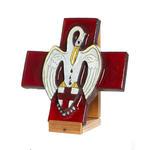Ceramic Red Cross emblem with pelican motif
Maker and role
Paul Vermeire (Belgian, b.1928, d.1974): Artist
Production date
1963
Audio tour
See full details
Details
Description
Made by Belgian artist Paul Vermeire in 1963, the sculpture which was gifted to the British Red Cross symbolises the work of the Red Cross blood donation service. The piece is in the shape of the Red Cross emblem with a pelican standing atop a shield with a further emblem in the centre. The pelican is shown pecking itself with droplets of blood beneath. The object is made from clay, hand painted and glazed. On the reverse are stamped the artist's initials, P.V. and there is also a metal hook to enable it to be attached to its wooden display stand.
Blood transfusion is an area in which the British Red Cross has a long history. In 1921, Percy Lane Oliver from the Red Cross division in Camberwell, London assisted Kings College Hospital with the search for a volunteer to donate blood to save a sick patient’s life. It was this incident that gave him the idea of setting up a pool of donors who would be willing to give blood at any hospital around the clock – thus beginning the UK’s first blood transfusion service. The British Red Cross continued its involvement in blood transfusion even after the NHS was established in 1948, ending its involvement in 1987.
Pelican imagery is not unique to Belgium in relation to blood donation. It has been used by a number of blood transfusion services including the Republic of Ireland and Estonia. In 1956, Belgium issued a series of stamps featuring the pelican to encourage people to give blood. The association has its origins in the mistaken belief that when food was scarce, the pelican fed its young by pecking at itself for blood (in actual fact, it has pouches in which it stores food). In spite of this, the pelican has become a symbol of self-sacrifice for good.
Although the British Red Cross has practical apparatus connected to the blood transfusion within its collections, it is the imagery surrounding this object and the folklore surrounding the pelicans that appeals to me. Also as someone who is not great with needles, the idea of self-sacrifice for good in relation to blood donation resonates with me in particular. The object was a gift from the Belgian Red Cross society and that is another element of why I have chosen it, as the cooperation between different national societies feels as important today as it ever did.
Audio recording by Charlie Burns (Collections Auditor, British Red Cross Museum & Archives).
Blood transfusion is an area in which the British Red Cross has a long history. In 1921, Percy Lane Oliver from the Red Cross division in Camberwell, London assisted Kings College Hospital with the search for a volunteer to donate blood to save a sick patient’s life. It was this incident that gave him the idea of setting up a pool of donors who would be willing to give blood at any hospital around the clock – thus beginning the UK’s first blood transfusion service. The British Red Cross continued its involvement in blood transfusion even after the NHS was established in 1948, ending its involvement in 1987.
Pelican imagery is not unique to Belgium in relation to blood donation. It has been used by a number of blood transfusion services including the Republic of Ireland and Estonia. In 1956, Belgium issued a series of stamps featuring the pelican to encourage people to give blood. The association has its origins in the mistaken belief that when food was scarce, the pelican fed its young by pecking at itself for blood (in actual fact, it has pouches in which it stores food). In spite of this, the pelican has become a symbol of self-sacrifice for good.
Although the British Red Cross has practical apparatus connected to the blood transfusion within its collections, it is the imagery surrounding this object and the folklore surrounding the pelicans that appeals to me. Also as someone who is not great with needles, the idea of self-sacrifice for good in relation to blood donation resonates with me in particular. The object was a gift from the Belgian Red Cross society and that is another element of why I have chosen it, as the cooperation between different national societies feels as important today as it ever did.
Audio recording by Charlie Burns (Collections Auditor, British Red Cross Museum & Archives).
Collection Type
Objects
Production Place
Media/Materials
History
Pelican imagery is not unique to Belgium and is or has been used by a number of blood transfusion services including the Republic of Ireland and Estonia. In 1956, Belgium issued a series of stamps featuring the pelican to encourage people to give blood. When food was scarce, the pelican was believed to feed its young by pecking at itself for blood (in fact, the pelican has pouches in which its stores food) and thus became an appropriate symbol throughout history of self-sacrifice for good.
Catalogue Number
0404/1
Associated Person and Role
Commissioned by: Belgian Red Cross
Designed by: Paul Vermeire (Belgian, b.1928, d.1974)
Designed by: Paul Vermeire (Belgian, b.1928, d.1974)
Associated Place
Subject Place
Associated Person
Subject auto tags
Object Types
Place Made
Part of 1 highlight set
Share
All images are the property of the British Red Cross Museum and Archives (unless otherwise indicated), and cannot be used without permission. For queries about permission to use images, please contact enquiry@redcross.org.uk.


-1%20(002).jpg)